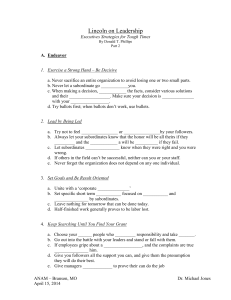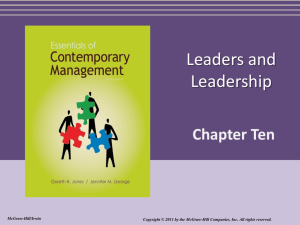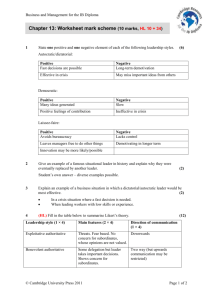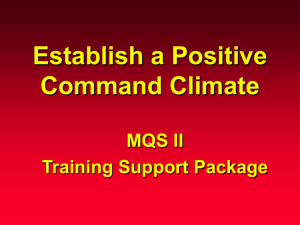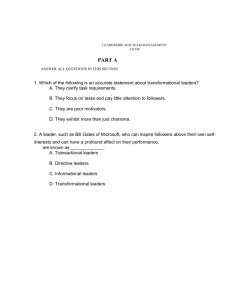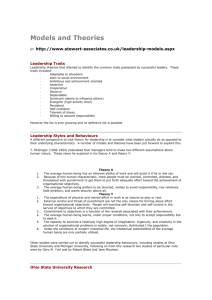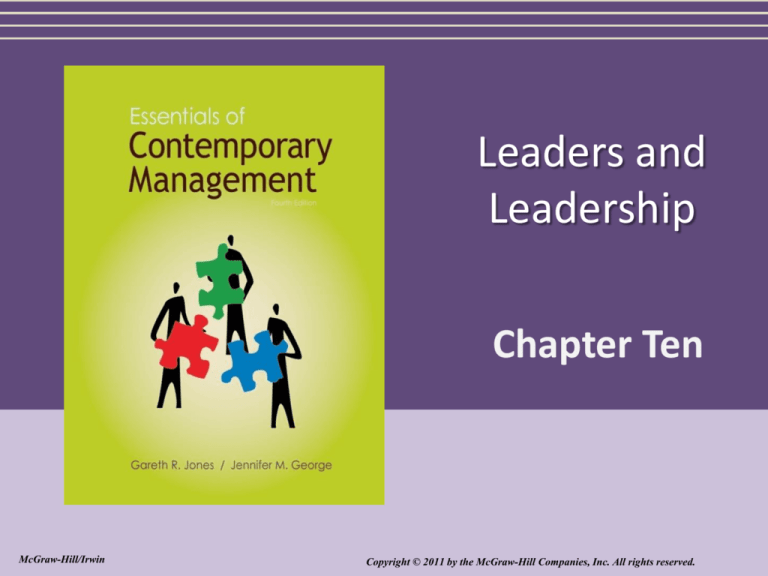
Leaders and
Leadership
Chapter Ten
McGraw-Hill/Irwin
Copyright © 2011 by the McGraw-Hill Companies, Inc. All rights reserved.
Learning Objectives
LO1 Describe what leadership is, when leaders are
effective and ineffective, and the sources of power
that enable managers to be effective leaders
LO2 Identify the traits that show the strongest
relationship to leadership, the behaviors leaders
engage in, and the limitations of the trait and
behavioral models of leadership
10-2
Learning Objectives (cont.)
LO3 Explain how contingency models of leadership
enhance our understanding of effective leadership
and management in organizations
LO4 Describe what transformational leadership is, and
explain how managers can engage in it
LO5 Characterize the relationship between gender and
leadership and explain how emotional intelligence
may contribute to leadership effectiveness.
10-3
The Nature of Leadership
• Leadership
–The process by which a person exerts influence
over other people and inspires, motivates and
directs their activities to help achieve group or
organizational goals
10-4
The Nature of Leadership
• Leader
– An individual who is
able to exert
influence over other
people to help
achieve group or
organizational goals
10-5
The Nature of Leadership
• Personal Leadership Style
– The specific ways in which a manager chooses to
influence others shapes the way that manager
approaches the other tasks of management.
– The challenge is for managers at all levels to
develop an effective personal management
style
10-6
The Nature of Leadership
• Servant leaders
– leader who has a strong desire to serve and work
for the benefit of others
– shares power with followers
– strives to ensure that followers’ most important
needs are met
10-7
Discussion Question
What culture has the most effective leadership
style?
A. Japanese
B. European
C. United States
D. Middle Eastern
10-8
Leadership Across Cultures
Leadership styles may vary among different
countries or cultures
– European managers tend to be more peopleoriented than American or Japanese managers
– Japanese managers are group-oriented, while U.S
managers focuses more on profitability
– Time horizons also are affected by cultures
10-9
Sources of Managerial Power
Figure 10.1
10-10
Question
What type of power is the ability of a manager
to give or withhold tangible and intangible
rewards?
A. Reward
B. Coercive
C. Expert
D. Legitimate
10-11
Power: The Key to Leadership
• Legitimate Power
– The authority that a manager has by virtue of his
or her position in an organizational hierarchy
• Reward Power
– The ability of a manager to give or withhold
tangible and intangible
rewards
10-12
Power: The Key to Leadership
• Coercive Power
–The ability of a manager to punish others
• Expert Power
–Power that is based on special knowledge, skills,
and expertise that a leader possesses
10-13
Power: The Key to Leadership
• Referent Power
– Power that comes from subordinates’ and
coworkers’ respect for the personal characteristics
of a leader which earns their loyalty and
admiration.
10-14
Empowerment: An Ingredient in Modern
Management
• Empowerment
– The process of giving workers at all levels more
authority to make decisions and the responsibility
for their outcomes
10-15
Empowerment: An Ingredient in Modern
Management
Empowerment:
• Increases a manager’s ability to get things done
• Increases workers’ involvement, motivation, and
commitment
• Gives managers more time to concentrate on their
pressing concerns
10-16
Leadership Models
• Trait Model
– Focused on identifying personal characteristics
that cause effective leadership.
– Many “traits” are the result of skills and
knowledge and effective leaders do not
necessarily possess all of these traits.
10-17
Question?
Which leadership model identifies the two basic
types of behavior that many leaders engaged
in to influence their subordinates?
A. Fiedler
B. Path-Goal
C. Behavioral
D. Trait
10-18
The Behavior Model
• Behavioral Model
– Identifies the two basic types of behavior that
many leaders engaged in to influence their
subordinates
10-19
The Behavior Model
• Consideration
– behavior indicating that
a manager trusts,
respects, and cares
about subordinates
• Initiating structure
– behavior that managers
engage in to ensure that
work gets done,
subordinates perform
their jobs acceptably,
and the organization is
efficient and effective
10-20
Contingency Models of Leadership
• Contingency Models
– Whether or not a manager is an effective leader is
the result of the interplay between what the
manager is like, what he does, and the situation in
which leadership
takes place
10-21
Contingency Models of Leadership
• Fiedler’s Model
– Personal characteristics can influence leader
effectiveness
– Leader style is the manager’s characteristic
approach to leadership
10-22
Contingency Models of Leadership
• Relationship-oriented
style
– leaders concerned with
developing good
relations with their
subordinates and to be
liked by them.
• Task-oriented style
– leaders whose primary
concern is to ensure that
subordinates perform at
a high level and focus on
task accomplishment
10-23
Fiedler’s Model
• Situation Characteristics
– How favorable a situation is for leading to occur
– Leader-member relations—determines how much
workers like and trust their leader
10-24
Fiedler’s Model
• Task structure
– the extent to which workers tasks are clear-cut so
that a leader’s subordinates know what needs to
be accomplished and how to go about doing it
• Position Power
– the amount of legitimate, reward, and coercive power
leaders have by virtue of their position
– When positional power is strong, leadership
opportunity becomes more favorable
10-25
Fiedler’s Contingency Theory of
Leadership
Figure 10.2
10-26
House’s Path-Goal Theory
A contingency model of leadership proposing the
effective leaders can motivate subordinates by:
1.Clearly identifying the outcomes workers are trying
to obtain from their jobs.
2.Rewarding workers for high-performance and goal
attainment with the outcomes they desire
3.Clarifying the paths to the attainment of the goals,
remove obstacles to performance, and express
confidence in worker’s ability.
10-27
House’s Path-Goal Theory
• Directive behaviors
– set goals, assign
tasks, show how to
do things
• Supportive behavior
– look out for the
worker’s best
interest
10-28
House’s Path-Goal Theory
• Participative
behavior
– give subordinates a
say in matters that
affect them
• Achievementoriented behavior
– Setting very
challenging goals,
believing in worker’s
abilities
10-29
The Leader Substitutes Model
• Leadership Substitute
– A characteristic of a subordinate or characteristic
of a situation or context that acts in place of the
influence of a leader and makes leadership
unnecessary
10-30
The Leader Substitutes Model
• Possible substitutes can be found in:
– Characteristics of the subordinates: their skills,
experience, motivation.
– Characteristics of context: the extent to which
work is interesting and fun.
10-31
Transformational Leadership
• Leadership that:
– Makes subordinates aware of the importance of
their jobs and performance to the organization by
providing feedback to the worker
– Makes subordinates aware of their own needs for
personal growth and development
– Motivates workers to work for the good of the
organization, not just themselves
10-32
Being a Charismatic Leader
• Charismatic Leader
– An enthusiastic, self-confident transformational
leader who is able to clearly communicate his or
her vision of how good things could be
10-33
Intellectual Stimulation
• Intellectual Stimulation
– Behavior a leader engages in to make followers be
aware of problems and view these problems in
new ways, consistent with the leader’s vision
10-34
Developmental Consideration
• Developmental
Consideration
– Behavior a leader
engages in to
support and
encourage followers
and help them
develop and grow on
the job
10-35
Transactional Leadership
• Transactional Leaders
– Leaders that motivate subordinates by rewarding
them for high performance and reprimanding
them for low performance
10-36
Gender and Leadership
• The number of women managers is rising but
is still relatively low in the top levels of
management.
• Stereotypes suggest women are supportive
and concerned with interpersonal relations.
Similarly, men are seen as task-focused.
10-37
Emotional Intelligence and Leadership
• The Moods of Leaders:
– Groups whose leaders experienced positive
moods had better coordination
– Groups whose leaders experienced negative
moods exerted more effort
10-38
Emotional Intelligence and Leadership
• Emotional Intelligence
– Helps leaders develop a vision for their firm
– Helps motivate subordinates to commit to the
vision
– Energizes subordinates to work to achieve the
vision
10-39
Video Case: Google Extends Charitable
Giving
• Are Google co-founders Brin and Page servant
leaders? How about Larry Brilliant?
• What would you say is the biggest source of
Larry Brilliant’s power as a leader?
• How does google.org illustrate empowerment
at Google?
10-40


